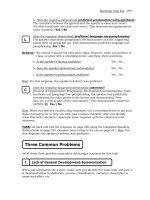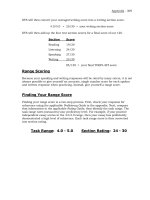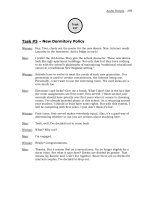Developing synthetic strategies for ligand free noble metal nanostructures
Bạn đang xem bản rút gọn của tài liệu. Xem và tải ngay bản đầy đủ của tài liệu tại đây (6.03 MB, 139 trang )
DEVELOPING SYNTHETIC STRATEGIES FOR
LIGAND-FREE NOBLE METAL NANOSTRUCTURES
SHAIK FIRDOZ
(M.Tech, IIT-Roorkee, India)
A THESIS SUBMITTED
FOR THE DEGREE OF DOCTOR OF PHILOSOPHY
DEPARTMENT OF CHEMICAL AND BIOMOLECULAR ENGINEERING
NATIONAL UNIVERSITY OF SINGAPORE
2014
DECLARATION
I hereby declare that this thesis is my original work and it has been written by me in its
entirety. I have duly acknowledged all the sources of information which have been used in
the thesis.
This thesis has also not been submitted for any degree in any university previously.
SHAIK FIRDOZ
19 Dec 2014
Acknowledgement
Acknowledgement
Firstly, I would like to express my sincere heartfelt gratitude to my supervisor, Asst.
Prof. Lu Xianmao, for his suggestions, invaluable guidance and continuous support given to
me during my entire PhD candidature.
In the same, I would like to extend my sincere thanks to the Department of Chemical and
Biomolecular Engineering for offering me a NUS research scholarship, which helps me a lot
to complete my PhD studies successfully without any financial hurdles during my PhD
candidature.
I would like to express my thanks to my lab mates Dr. Zhang Weiqing, Dr. Niu Wenxin,
Dr. Sun Zhipeng, Dr. Chen Ningping, Dr. Han Hui, Dr. Guo Chunxian, Dr. Chen Shaofeng,
Mr. Ton Tran, Ms. Zhao Dieling, Mr. Zhao Qipeng, Mr. Chen Shucheng and Ms. Gamze
Yilmaz for their valuable discussions and the good fun we shared in the lab.
I would like to thank Mr. Chia Phai Ann, Mr. Liu Zhicheng, Mr. Mao Ning, Dr. Yuan
Zeliang, Dr. Yang Liming, Mr. Tan Evan Stephen, Mr. Ang Wee Siong, Ms. Li Fengmei, Ms.
Li Xiang and Ms. Samantha for their kind support and help during my PhD candidature.
I would like to thank specially my friends Mr. Karthik, Mr. Akshay, Mr. Dara Nuthan
and Mr. Sai Naresh reddy for their kind help, suggestions and tons of fun given to me and
make my stay very pleasant and happy.
Finally, I would like to express my deepest love to my beloved parents, parent-in-law
and brother-in-law Mr. Shaik Abid, for their kind support. Last but not least, my sincere and
special thanks given to my wife Ms. Shaik Asma for her un-conditional support and help
i
Acknowledgement
during my study. It is not exaggeration to say that I could not able to complete my PhD work
without her support and love. I would like to extent my sincere thanks to all my friends and
well-wishers who directly or indirectly help me to finish my PhD work.
ii
Table of Contents
Table of Contents
Acknowledgement ............................................................................... i
Summary .......................................................................................... viii
List of Abbreviations ......................................................................... xi
List of Figures .................................................................................. xiii
List of Tables .................................................................................... xxi
Chapter 1. Introduction ......................................................................1
1.1 Background .................................................................................................. 1
1.2 Objectives .................................................................................................... 2
1.3 Organization of thesis .................................................................................. 3
Chapter 2. Literature Review ............................................................4
2.1 Core-shell nanoparticles .............................................................................. 4
2.2 Rattle–type hollow structures (Yolk-shell / Nanorattles)............................ 5
2.3 Methodologies for the fabrication of noble metal (M@SiO2) YSNs .......... 6
2.3.1 Synthetic approaches .................................................................................................... 6
2.3.2 Selective etching or dissolution method ...................................................................... 7
2.3.3 Pre-shell method or Ship-in-bottle method ................................................................ 14
2.3.4 Template free methods ............................................................................................... 18
2.3.5 Galvanic replacement method .................................................................................... 19
2.3.6 One pot method .......................................................................................................... 19
2.4 Applications of Yolk-shell noble metal nanoparticles .............................. 22
iii
Table of Contents
2.4.1 Yolk-shell nanoparticles as nanoreactors ................................................................... 22
2.4.2 Yolk-shell nanoparticles as drug delivery carriers ..................................................... 26
2.4.3 Yolk-shell nanoparticles for lithium-ion batteries ..................................................... 28
2.5 Our Proposed Method................................................................................ 29
Chapter 3. Experimental Section .....................................................31
3.1 Method and materials ................................................................................ 31
3.2 Solution preparation .................................................................................. 32
3.3 Procedures ................................................................................................. 32
3.3.1 Synthesis of mesoporous hollow silica shells of size 100 nm and 230 nm (mHSS-100
& mHSS-230)...................................................................................................................... 32
3.3.2 Synthesis of silica spheres (SiO2) .............................................................................. 33
3.3.3 Synthesis of ligand-free Au@SiO2 nanorattles by thermal method ........................... 34
3.3.4 Catalytic reduction of 4-nitrophenol by Au@SiO2 nanorattles ................................. 35
3.4 Synthesis of ligand-free Au nanoplates by photochemical reduction
method ............................................................................................................. 36
3.4.1 Synthesis of spherical gold yolk-shell nanoparticles in absence of Ag+ ions
(Au@mHSS) ....................................................................................................................... 36
3.4.2 Synthesis of Au triangular nanoplates in the presence of Ag+ ions ........................... 37
3.4.3 Etching of Au triangular yolk-shell nanoplates with HF ........................................... 37
3.5 Synthesis of ligand-free M@SiO2 (M= Au, Ag, Pt and Pd) nanorattles by
using mHSS as smart nanoreactors ................................................................. 38
3.5.1 Synthesis of Ag@mHSS yolk-shell nanoparticles ..................................................... 38
3.5.2 Synthesis of Ag@mHSS yolk-shell nanoparticles with different pH values ............. 38
3.5.3 Synthesis of Au@mHSS yolk-shell nanoparticles ..................................................... 38
iv
Table of Contents
3.5.4 Synthesis of Pd@mHSS yolk-shell nanoparticles ..................................................... 39
3.5.5 Synthesis of Pt@mHSS yolk-shell nanoparticles ...................................................... 39
3.6 Characterization Methods .......................................................................... 39
3.6.1 Ultraviolet-visible spectrophotometer (UV-Vis) ....................................................... 39
3.6.2 X-ray photoelectron spectroscopy (XPS)................................................................... 39
3.6.3 Inductively coupled plasma mass spectrometry (ICP-MS) ........................................ 40
3.6.4 Brunauer-Emmett-Teller (BET) measurements for mHSS-100 and mHSS-230 ....... 40
3.6.5 Zeta-Potential measurements ..................................................................................... 40
3.6.6 FT-IR measurement for mHSS-100 ........................................................................... 41
3.6.7 Mass spectrum analysis of different noble metal precursor’s solutions..................... 41
3.6.8 Scanning electron microscopy (SEM) ....................................................................... 41
3.6.9 Transmission electron microscopy (TEM) ................................................................. 41
Chapter 4. Volume-confined Synthesis of Ligand-free Gold
Nanoparticles with Tailored Sizes for Enhanced Catalytic Activity
.............................................................................................................42
4.1 Introduction ............................................................................................... 42
4.2 Results and discussion ............................................................................... 45
4.2.1 Synthesis of mesoporous hollow silica shells (mHSS) .............................................. 45
4.2.2 Synthesis of Au@SiO2 nanorattles using mHSS-230 ................................................ 46
4.2.3 Characterizations of Au@mHSS nanorattles ............................................................. 49
4.2.4 Synthesis of Au@SiO2 nanorattles using mHSS-100 ................................................ 52
4.2.5 Catalytic activities of Au@SiO2 nanorattles for reduction of 4-nitrophenol (4-NP) to
4-aminophenol (4-AP) in presence of excess NaBH4 ......................................................... 54
4.3 Conclusion ................................................................................................. 60
v
Table of Contents
Chapter 5. Synthesis of Ligand-free Au Triangular Nanoplates.61
5.1 Introduction ............................................................................................... 61
5.2 Results and discussion ............................................................................... 64
5.2.1 Synthesis of Au triangular nanoplate inside mHSS ................................................... 64
5.2.2 Characterizations of Au triangular nanoplates ........................................................... 65
5.2.3 Synthesis of spherical gold nanoparticles inside mHSS in the absence of Ag+ ions.. 68
5.2.4 Effect of chloride ions on the formation of Au triangular nanoplates ....................... 70
5.2.5 Proposed mechanism for the growth of Au triangular nanoplate inside mHSS ........ 70
5.3 Conclusion ................................................................................................. 73
Chapter 6. Synthesis of M@SiO2 (M = Ag, Au, Pd, Pt) Yolk-Shell
Nanoparticles .....................................................................................74
6.1 Introduction ............................................................................................... 74
6.2 Results and discussion ............................................................................... 76
6.2.1 Synthesis of ligand-free M@SiO2 nanorattles (M = Ag, Au, Pd & Pt) using mHSS 76
6.2.2 Characterizations of ligand-free M@SiO2 nanorattles (M = Ag, Au, Pd & Pt) ......... 78
6.3 Growth mechanism for the formation of ligand-free nanorattles.............. 79
6.3.1 Synthesis of Ag@mHSS nanorattles at different time periods .................................. 79
6.3.2 Synthesis of Ag@mHSS nanorattles at different pH values ...................................... 82
6.3.3 Proposed mechanism for the formation of ligand-free nanorattles ............................ 84
6.3.4 Effect of nanocavity of mHSS on the formation of ligand-free nanorattles .............. 86
6.4 Conclusion ................................................................................................. 87
Chapter 7. Conclusions and Future Work .....................................89
7.1 Conclusions ............................................................................................... 89
vi
Table of Contents
7.2 Future Work ............................................................................................... 93
References .........................................................................................96
Annexure ......................................................................................... 115
List of Publications ........................................................................................ 115
vii
Summary
Summary
As an important class of nanomaterials, noble metal nanostructures (NMNs) have
attracted significant attention because of their wide variety of applications in catalysis,
photonics, sensing and medicine. It is well known that the catalytic and optical properties of
NMNs can be effectively tailored by tuning their size and shape. Therefore, a number of
synthetic routes have been developed for morphology-controlled synthesis of NMNs. Among
these synthetic methods, wet chemical synthesis is probably the most powerful approach to
the preparation of noble metal nanostructures in large quantity with controlled shapes, sizes,
and compositions. To achieve control over shape and size during synthesis, capping ligands
such as polymers, surfactants, dendrimers, or small organic molecules are generally
employed. However, the presence of ligands on the surface of NMNs may drastically affect
their catalytic activity, stability, and suitability for biological applications. Especially for
catalysis, bare NMNs free of capping ligands are highly desirable. But without capping
ligands, it is difficult to tailor the size and morphology of the nanoparticles since they would
all grow into the most thermodynamically stable form. In addition, ligand-free NMNs are
highly unstable and easily aggregate in solution.
Therefore, the objective of the current research is to design synthetic methods for ligandfree NMNs with controllable size, shape, composition and exposed facets. Firstly, we
developed a volume-confined method to tune the size of gold nanoparticles inside the cavity
of mesoporous hollow silica shells (mHSS) without using any organic capping ligands. In this
method, mHSS with an average sizes of 100 ± 2.3 nm (mHSS-100, pore volume: 1.321
cm3/g) and 230 ± 4.2 nm (mHSS-230, pore volume: 0.215 cm3/g) were synthesized by using
viii
Summary
a modified Stober’s method. mHSS were infiltrated with HAuCl4 solution followed by
centrifugation to separate impregnated mHSS with AuCl4- ions from the bulk solution. A
simple heating process was then employed to convert the Au precursor solution trapped in the
cavity of mHSS into spherical Au nanoparticles. The sizes of the Au nanoparticles were
tailored by simply varying the concentration of Au precursor solution loaded inside the cavity
of mHSS, or by using mHSS with different cavity volumes. The resulting ligand-free Au
nanoparticles exhibited much enhanced catalytic activity towards the reduction of 4nitrophenol to 4-aminophenol with NaBH4 compared to citric acid-capped Au nanoparticles
of the same size.
Next, a photochemical reduction method together with the introduction of Ag+ ions was
developed to grow ligand-free Au triangular nanoplates inside the cavity of mHSS. In this
case, mHSS were soaked in a mixture of HAuCl4, ethanol and AgNO3 solution. After
centrifugation, the samples were exposed to UV light. The ethanol molecules trapped inside
the mHSS generated radicals which acted as reducing agent to reduce AuCl4-. The resulting
Au atoms nucleated inside the mHSS and grew into nanoparticles. The shape of the gold
nanoparticles was successfully tuned from spheres to triangular nanoplates by varying the
ratio of [AuCl4-]:[Ag+]. It is believed that the presence of Ag+ ions can alter the reduction
kinetics of AuCl4- and facilitate the development of twinned seeds, which gradually develop
into Au triangular nanoplates inside the nanocavity of mHSS. The effect of Ag+ and ethanol
for the formation of Au triangular nanoplates was examined.
Finally, we extended the synthesis of ligand-free nanoparticles to other noble metals
including Ag, Pd, Pt which cannot be obtained inside of mHSS by using simple heating
methods. In this study, the precursor solutions of different noble metals were loaded inside
ix
Summary
the mHSS first. The growth of nanoparticles was achieved by tuning deprotonated species
(≡Si-O-) present on the mHSS with different pH range of solution. It was found that pH > 4 is
required for the synthesis of ligand-free Ag, Pd, Pt, as well as Au nanoparticles, while at pH
<4, nanoparticles were not formed. This is because at pH > 4, deprotonated species (≡Si-O-)
present on the mHSS surface can act as reducing agent for the conversion of noble metal
precursor ions into metal atoms. The nanocavity of mHSS also plays a critical role to lower
the critical radius of nucleation for the growth of nanoparticles inside the cavity of mHSS.
x
List of Abbreviations
List of Abbreviations
YSNs
Yolk-shell nanoparticles
mHSS
Mesoporous hollow silica shells
NMNs
Noble metal nanostructures
NPs
Nanoparticles
SiO2
Silicon dioxide
M@SiO2
M = Ag, Au, Pd, Pt
PS-124
Polystyrene beads (124 nm)
PS-266
Polystyrene beads (266 nm)
Au
Gold
Ag
Silver
Pd
Palladium
Pt
Platinum
AgNO3
Silver nitrate
H2PtCl6.xH2O
Chloroplatinic acid hydrate
HAuCl4∙3H2O
Gold(III) chloride trihydrate
Na2PdCl4
Sodium tetrachloropalladate
NaOH
Sodium hydroxide
HNO3
Nitric acid
DI H2O
Deionized water
NH3.H2O
Ammonia solution
VTMS
Vinyltrimethoxysilane
HF
Hydrofluoric acid
PBzMA
Poly(benzyl methacrylate)
NaCl
Sodium chloride
PEMs
Polyelectrolyte multilayers
MF
Melamine-formaldehyde
HCl
Hydrochloride acid
TEOS
Tetra ethyl orthosilicate
TSD
N-3-(trimethoxysilyl) propyl ethylenediamine
xi
List of Abbreviations
PVP
Poly(N-vinyl-2-pyrrolidone)
SPR
Surface plasmon resonance
UV
Ultraviolet
CTAB
Hexadecyltrimethylammonium bromide
SERS
Surface enhanced Raman scattering
PS-co-PMAA
Poly(styrene-co-methylacrylic acid)
TOF
Turn over frequency
PEG
Polyethylene glycol
DOX
Doxorubicin
IBU
ibuprofen
MRI
Magnetic resonance imaging
PEO-PPO-PEO
Polymer(poly(ethyleneoxide)-poly(propyleneoxide)poly(ethylene)
SC
EDX
Sodium citrate
oxide),
Energy dispersive X-ray spectroscopy
FESEM
Field Emission Scanning Electron Microscopy
TEM
Transmission electron microscopy
HRTEM
High-Resolution Transmission Electron Microscopy
UV-Vis
Ultraviolet-Visible
XPS
X-ray Photoelectron Spectroscopy
ICP-MS
Inductively coupled plasma mass spectrometry
ECSAs
Electrochemically activated surface areas
BET
Brunauer-Emmett-Teller
SAED
Selected Area Electron Diffraction
FT-IR
Fourier transform infrared spectroscopy
4-AP
4-aminophenol
4-NP
4-nitrophenol
xii
List of Figures
List of Figures
Figure 2.1 Different core/shell nanoparticles: (a) spherical core/shell nanoparticles; (b)
hexagonal core/shell nanoparticles; (c) multiple small core materials coated by single shell
material; (d) nanomatryushka material; (e) movable core within hollow shell material.
Reprinted with permission from reference.7 .............................................................................. 5
Figure 2.2 Schematic illustration of etching strategies for preparing YSNs. Reprinted with
permission from reference.20...................................................................................................... 6
Figure 2.3 (A, B) Backscattering SEM and (C, D) TEM images of Au@SiO2@PBzMA
particles before (A, C) and after (B, D) HF etching. (E, F) TEM images of
Au@SiO2@PBzMA synthesized at different time periods of polymerization: (E) 3 h and (F)
6 h. Reprinted with permission from reference.22 ...................................................................... 8
Figure 2.4 TEM images of (A) PS-co-P4VP microspheres, (B) Au/PS-co-P4VP
microspheres, (C, D) Au/PS-co-P4VP@HMSM microspheres, and (E, F) Au@HMSM yolkshell microspheres. Reprinted with permission from reference.23 ............................................. 9
Figure 2.5 TEM images of (A) Au-decorated PS nanospheres, (B) PS@Au@silica colloids,
and (C) hollow silica spheres with multi Au nanoparticles after burning off PS templates. (D)
Backscattering SEM (inset, normal SEM) image of multicore hollow silica spheres.
Reprinted with permission from reference.24 ........................................................................... 10
Figure 2.6 (a) Schematic illustration for the synthesis of Au@mSiO2 and Fe2O3@mSiO2
YSNs; TEM images of (b) Au@SiO2@mSiO2, (c) rattle-type Au@mSiO2, (d and inset)
xiii
List of Figures
ellipsoidal Fe2O3@SiO2@mSiO2, (e, inset: SEM image of deliberately selected broken
ellipsoids) rattle-type Fe2O3@mSiO2. Reprinted with permission from reference.28 .............. 12
Figure 2.7 (a-f) TEM images of Au@SiO2 nanoreactors and (g, h) silica hollow shells. (a, b)
Gold core diameters are 104±9 nm, (c, d) 67±8 nm, and (e, f) 43±7 nm. The scale bars
represent 200 nm (a, c, e, and g) and 100 nm (b, d, f, h). Reprinted with permission from
reference.18 ............................................................................................................................... 13
Figure 2.8 Schematic procedure for the preparation of yolk/shell nanoparticles through the
ship-in-bottle method. Reprinted with permission from reference.20 ...................................... 14
Figure 2.9 TEM images of hollow silica particles (a) and Cu core rattle-type silica particles
(b: 1 cycle; c: 2 cycles; d: 3 cycles). Reprinted with permission from reference.31 ................ 15
Figure 2.10 Schematic procedure for the preparation of PPy-CS hollow nanospheres
containing movable Ag Cores (Ag@PPy-CS). Reprinted with permission from reference.33 16
Figure 2.11 TEM images of (a) silica nanorattles of 110 nm, (b) SRG-1, (c) SRG-2, and (d)
SRG-3. Reprinted with permission from reference.34.............................................................. 17
Figure 2.12 Schematic formation of SnO2 hollow spheres inside mesoporous silica
nanoreactors. Reprinted with permission from reference.35 .................................................... 17
Figure 2.13. TEM images showing the formation of hollow CoSe nanocrystals, from top-left
to bottom-right: 0 s, 10 s, 20 s, 1 min, 2 min, and 30 min. The Co/Se molar ratio was 1:1.
Reprinted with permission from reference.36 ........................................................................... 18
xiv
List of Figures
Figure 2.14 TEM images of Au@HSNs synthesized using 1 ml of HAuCl4 solution: (a-b)
before calcination and after being washed several times with water; scale bars: 50 and 20 nm,
respectively; (c-d) after calcination, the small clusters of Au aggregate to give larger Au
nanoparticles (indicated by white arrows); scale bars: 100 and 20 nm, respectively. Reprinted
with permission from reference.44............................................................................................ 20
Figure 2.15 (A) Structural illustration of an Au@oxide composite nanoreactor. (B) TEM
image of Au@oxide composite nanoreactors. (C) Typical reactions tested for Au@oxide
composite nanoreactors. Reprinted with permission from reference.20 ................................... 23
Figure 2.16 (A) TEM images of Au@SiO2 yolk-shell nanoreactors, and (B) Time-dependent
UV-vis spectral changes of Au@SiO2 yolk/shell nanoreactors used for catalytic studies.
Reprinted with permission from reference.46 ........................................................................... 25
Figure 2.17 (A) TEM images of (a) Au@SiO2, (b) Au@SiO2@ZrO2, (c) Au@hm-ZrO2, (d)
Au@SiO2@TiO2, and (e) Au@hm-TiO2. (B) A comparison of catalytic activity for CO
oxidation by Au@hm-TiO2 (squares) and Au@hm-ZrO2 (circles) nanoreactors calcinated at
100 °C and 300 °C respectively. Reprinted with permission from reference.49....................... 25
Figure 2.18 (A) Schematic illustration for the synthesis of Pd@mesoporous silica composite
nanoreactors. (B) TEM images of Pd@mesoporous silica composite nanoreactors. (C)
Typical Suzuki reaction. Reprinted with permission from reference.20................................... 26
Figure 2.19 (A) Schematic illustration for the synthesis of YSNs-PEG/FA. (B) A possible
mechanism accounting for killing of MCF-7 cells by DOX-YSNs. Reprinted with permission
from reference.20 ...................................................................................................................... 27
xv
List of Figures
Figure 2.20 TEM images of (a) Co@Au nanospheres and (b) cells exposed to Co@Au
nanospheres. Reprinted with permission from reference.56 ..................................................... 28
Figure 4.1 Schematic illustration for the synthesis of ligand-free Au nanoparticles using
hollow mesoporous silica shells............................................................................................... 44
Figure 4.2 TEM images of (a) PS-266@SiO2 core-shell particles, (b) 230-nm SiO2 hollow
shells, and (c) SEM image of 230-nm SiO2 hollow shells....................................................... 45
Figure 4.3 N2 adsorption-desorption isotherms of (a) mHSS-100 and (c) mHSS-230; and
pore size distributions of (b) mHSS-100 and (d) mHSS-230. ................................................. 46
Figure 4.4 TEM images of (a) 230-nm SiO2 hollow shells and (b-f) Au nanoparticles with
diameters of 7 (Au@SiO2-7), 10 (Au@SiO2-10), 26 (Au@SiO2-26), 36 (Au@SiO2-36) and
42 nm (Au@SiO2-42) synthesized inside of the hollow shells using HAuCl4 solutions of
0.005, 0.01, 0.1, 0.25 and 0.5 M, respectively. ........................................................................ 48
Figure 4. 5 Plot of measured and calculated particle diameters vs. [HAuCl4]1/3. ................... 49
Figure 4.6 (a) HRTEM image of a single Au nanoparticle in Au@SiO2-26. (b) UV-vis
extinction spectra of Au@SiO2-10, Au@SiO2-26, and Au@SiO2-36 (c, d) EDX line spectrum
of a single gold nanoparticle of Au@SiO2-26. ........................................................................ 50
Figure 4.7 EDX spectrum of Au@SiO2-26. ........................................................................... 51
Figure 4.8 XPS spectra of as-synthesized Au@SiO2-26: (a) Au 4f and (b) survey scan. ...... 51
xvi
List of Figures
Figure 4.9 (a) SEM and (b) TEM images of 100-nm SiO2 hollow shells (mHSS-100). (c, e, g)
TEM images of Au nanoparticles with diameters of 6 (Au@SiO2-6), 14 (Au@SiO2-14), 18
nm (Au@SiO2-18), synthesized inside of mHSS-100 by impregnating HAuCl4 solutions of
0.01, 0.25 and 0.5 M, respectively; (d, f, h) corresponding histograms of Au nanoparticle
sizes for Au@SiO2-6, Au@SiO2-14, and Au@SiO2-18 respectively; (i) a low magnification
.................................................................................................................................................. 53
Figure 4.10 Time-dependent UV-Vis absorption spectra for the reduction of 4-nitrophenol
catalyzed by (a) Au@SiO2-26 and (c) Au@SC-26, respectively. (b) ln(Ct/C0) vs. time for the
reduction of 4-nitrophenol catalyzed with Au@SiO2 and Au@SC nanoparticles of different
sizes in the presence of excess NaBH4. (d) Conversion of 4-nitrophenol vs. time (Inset: TOF
bar chart). ................................................................................................................................. 55
Figure 4.11 Time-dependent UV-Vis absorption spectra for the reduction of 4-nitrophenol
catalyzed by (a) Au@SC-10, (b) Au@SiO2-10, and (c) Au@SiO2-36, respectively. ............. 56
Figure 4.12 TEM images of sodium citrate-capped Au nanoparticles: (a) Au@SC-10, (c)
Au@SC-26 and (b, d) the corresponding histograms of Au nanoparticle sizes, respectively. 59
Figure 5.1 (a) Schematic illustration for the growth of ligand-free Au triangular nanoplates
and nanoparticles inside silica shells under UV irradiation. (b-d) TEM images of Au
nanocrystals synthesized under UV irradiation for 24 hours at different ratios of [AuCl4-]:
[Ag+] -- (b) 30:1; (c) 50:1; and (d) without Ag+. (e) UV-vis absorption spectra of the Au
nanocrystals.............................................................................................................................. 63
xvii
List of Figures
Figure 5.2 TEM images of (a) 124 nm PS beads, (b) PS-124@vinyl-SiO2, (c) mHSS, and (d)
FESEM image of mHSS. ......................................................................................................... 64
Figure 5.3 EDX elemental mappings of Au (red) and Ag (green) and the spectrum for the Au
nanoplates synthesized at Au:Ag = 30:1. All scale bars are 50 nm. ........................................ 65
Figure 5.4 (a) TEM image of the Au triangular nanoplates after the removal of silica shells.
(b) SAED pattern of a Au triangular nanoplate. (c) HRTEM image of a Au triangular
nanoplate. (d) TEM side view of a Au triangular nanoplate.................................................... 67
Figure 5.5 TEM images of Au triangular nanoplates synthesized in the presence of Ag+ ions
under UV irradiation at different times: (a) 1, (b) 6, (c) 12 and (d) 24 hrs (Scale bars: 50 nm).
The insets are the corresponding HRTEM images (Scale bars: 5 nm). ................................... 68
Figure 5.6 TEM images of Au@mHSS synthesized without Ag+ ions under UV light for
different time periods: (a) 1 hour, (b) 6 hour, (c) 12 hour and (d) 24 hour. (All scale bars are
50 nm). ..................................................................................................................................... 69
Figure 5.7 TEM images of the samples obtained by soaking mHSS in 0.1M aqueous HAuCl 4
solution for a period of 24 hours (a) with ethanol but no UV light irradiation and (b) with UV
light but without ethanol. (c) TEM image of Au@mHSS synthesized by soaking mHSS in a
mixture of 0.1 M HAuCl4 (prepared with saturated NaCl solution) and ethanol but without
Ag+ ions. .................................................................................................................................. 70
Figure 5.8 HRTEM images of Au seeds obtained in the presence and absence of Ag+ ions:
(a) twinned and (b) single crystalline seeds respectively......................................................... 72
xviii
List of Figures
Figure 6.1 Schematic illustration for the synthesis of ligand-free yolk-shell nanoparticles
M@mHSS (M=Ag, Au, Pd & Pt). ........................................................................................... 76
Figure 6.2 TEM images of ligand-free M@mHSS (M = Ag, Au, Pd & Pt) synthesized by
soaking mHSS in respective metal precursor solutions: (a) Ag@mHSS, (b) Au@mHSS, (c)
Pd@mHSS, and (d) Pt@mHSS. .............................................................................................. 77
Figure 6.3 Low magnification TEM images of (a) Ag@mHSS, (b) Au@mHSS, (c)
Pd@mHSS, and (d) Pt@mHSS. .............................................................................................. 78
Figure 6.4 (a, d, g, j) HRTEM images of Ag, Au, Pd and Pt core inside of mHSS. (b, e, h, k)
TEM images of M@mHSS (M= Ag, Au, Pd & Pt) and (c, f, i, l) the corresponding EDX
elemental mappings of Ag, Au, Pd, Pt (red), O (blue) and Si (green), respectively. (All
unmarked scale bars are 50 nm)............................................................................................... 79
Figure 6.5 TEM images of Ag@mHSS synthesized by soaking mHSS in 0.1M AgNO 3
solution for different time periods: (a) mHSS, (b) 1 min, (c) 1 hour, (d) 6 hour, (e) 12 hour
and (f) 24 hour. ........................................................................................................................ 81
Figure 6.6. UV-vis absorption spectra of mHSS, AgNO3 solution aged for 24 hours, and
mHSS in AgNO3 solution aged for 24 hours. ......................................................................... 82
Figure 6.7 TEM images of Ag@mHSS synthesized by soaking mHSS in 0.1M AgNO3
solution for a period of 1 hour at different pH values: (a) 1.6, (b) 2.3, (c) 3.1, (d) 4.2, (e) 5.3
and (f) 9.3. ................................................................................................................................ 83
Figure 6.8 Schematic illustration of the formation of metal core nanoparticles inside mHSS.
.................................................................................................................................................. 84
xix
List of Figures
Figure 6.9 FT-IR spectrum of mHSS. ..................................................................................... 85
Figure 6.10 TEM images of (a, c) Au and (b, d) Ag nanoparticles formed on the surface of
SiO2 spheres. ............................................................................................................................ 87
xx
List of Tables
List of Tables
Table 3.1 Chemicals and materials ......................................................................................... 31
Table 3.2 Concentration of Au present in different YSNs measured by ICP-MS. ................. 36
Table 4.1 Comparison of the catalytic activities of Au@SiO2 nanorattles and sodium citratecapped Au nanoparticles for the reduction of 4- nitrophenol. ................................................. 58
Table 6.1. Zeta-potentials of mHSS at different pH values. ................................................... 85
xxi
Chapter 1
Chapter 1. Introduction
1.1 Background
As an important class of nanomaterials, noble metal nanostructures (NMNs) have
attracted significant attention because of their wide variety of applications in catalysis,
photonics, sensing and medicine. Particularly, the catalytic and optical properties of NMNs
can be effectively tailored by tuning their size and shape. Among various synthetic methods,
wet chemical synthesis is probably the most powerful approach to prepare noble metal
nanostructures in large quantity and with controlled shape, size, and composition.
In typical wet chemical syntheses, capping agents are employed to achieve arrested
growth and control over the morphology of the resulting nanostructures. The functions of
capping agents are to prevent aggregation, increase stability, and direct the shape of the
nanoparticles. Using various capping agents, noble metal nanoparticles with diverse shapes
such as spheres, rods, cubes, disks, wires, tubes, branched, triangular prisms and tetrahedral
nanoparticles have been produced.1 But the presence of surfactants on the surface of
nanoparticles may drastically affect their catalytic activity, stability in harsh conditions and
usage in biological applications.2 For example, the activity of gold catalysts is detrimentally
affected when strong covalent capping agents (e.g., alkanethiol molecules and phosphine
complexes) are present even in minute amounts.3
Methods like laser ablation4 and bio-based approaches5-6 are currently available to
synthesize ligand-free noble metal nanoparticles. However, besides tedious procedures, the
difficulties in scaling up the synthesis and controlling the growth of nanoparticles have
1
Chapter 1
limited the use of these methods. In addition, bare NMNs are highly active and aggregate
easily.
1.2 Objectives
The current research objective is to develop synthetic methods for the growth of ligandfree NMNs with controllable size, shape, composition and exposed facets. Specially, we
employ mesoporous hollow silica shell (mHSS) as the templates to form nanoparticles inside
their cavity without using any capping ligands. The detailed research activities and scope of
the thesis are as follows:
A facile volume confined synthesis was developed for tuning the size of ligand-free Au
nanoparticles. In this method, mesoporous hollow silica shells were employed as
nanoreactors for tuning size and shape of noble metal nanostructures. mHSS served as nanocontainers for the impregnation of HAuCl4 solution before they were separated from the bulk
solution. With a simple heating process, the Au precursor confined within the cavity of the
isolated hollow shells was converted into ligand-free Au nanoparticles. The size of the Au
nanoparticles can be tuned precisely by loading HAuCl4 solution of different concentrations,
or by using mHSSs with different cavity volumes. With the reduction of 4-nitrophenol in
presence of NaBH4 as a model reaction, we further assessed the catalytic activity of the
ligand-free Au nanoparticles and found much improved performance compared to sodium
citrate capped Au nanoparticles.
A photochemical reduction method was introduced to tune the shapes of ligand-free gold
nanoparticles inside the nanocavity of mHSS in the presence of Ag+ ions. We found that, by
varying the molar ratio of [AuCl4-]: [Ag+] from 50:1 to 30:1 in the reaction, the shape of the
gold nanoparticles can be tailored from spheres to triangular plates.
2









